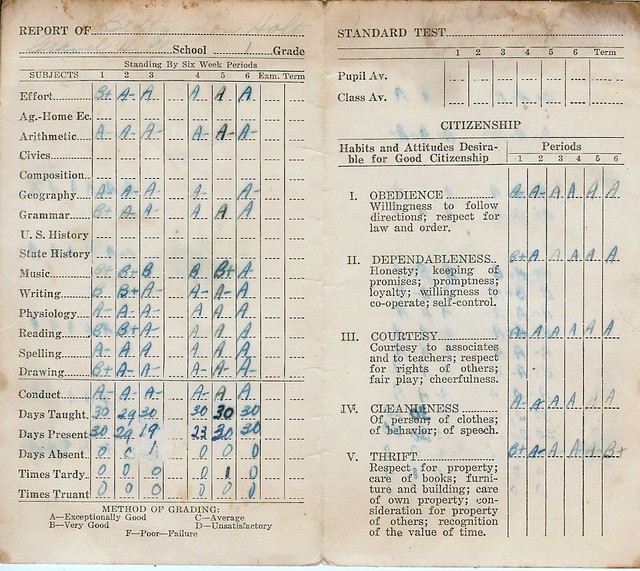At our university, content educators are mostly in their respective content departments, which is why we have a dozen or so math educators in our math department. In our secondary teacher prep, we have three courses that are our "Math Ed" courses: Math 229, which is HS content focused, Math 329 - which is MS content focused, and Ed 331 - which is our content seminar for teacher assisting, when the novice teachers are in schools for the mornings and teaching at least a unit. We are in negotiations to see them during student teaching, which will be excellent.
This is another guest post from a student assistant: Brock Walsh. He paused school for a bit, but then came back with a very clear motivation about wanting to be a teacher. Dave Coffey already
posted a bit from him, where he used the
NCTM process standards as an outside resources.
In his teacher assistant portfolio, he reused a bit from his 229 class, and I thought it was a neat opportunity to follow a student from early on until later in their teacher education. As an add on, I also included his piece from this past semester on the
Conditions of Learning, which Dave recently posted in the Learning Museum.
Equity -
Insights from the Past(The following is a paper that was written for MTH 229, in which I had looked into the principle of equity as I related it to my experience of a nine week observation.)
Articles: Excellence in the high school classroom is something that teachers strive for. Sometimes conducting a learning filled classroom can be easy, but other times a teacher might not fully see and take advantage of teachable moments for all students. Being aware of and preparing for these teachable opportunities for all students to learn at a higher cognitive level is vital and defined under the Equity Principle of the high school principles and standards.
The article “Focusing on students’ Mathematical Thinking” by M. Lynn Breyfogle and Beth A. Herbel-Eisenmann focuses on trying to understand the thought processes of a student’s reasoning instead of relying on a student’s answer. Reasoning occurs when a student has time to think and then explain their thoughts. The time that is given after a question and before an answer is known as “wait time” and within this time, a student’s cognitive thoughts will increase. In the article, the authors emphasize an important detail. They quote from their findings, “Although most teachers are aware of the importance of waiting after they have asked a question, the importance of waiting after a student responds has received less emphasis (Rowe 1986). This all relates to students maximizing their learning by having the time given to them so they can process ideas for themselves.
The article goes further to say that when a student has given a correct answer, we as teachers should question them as to how they arrived at that. Students will often learn the most from themselves or when another student explains their reasoning. Asking for justification is a great way to evaluate not only a student, but the class as a whole when they respond and get involved in the discussion. Putting both “wait time” and “justification” together strongly represents the idea of equity and its importance in class.
The article “Unveiling Student Understanding: The Role of Questioning in Instruction” by Azita Manouchehri and Douglas A. Lapp relates to the Equity Principle directly by emphasizing the point that we as teachers need to ask the right questions for optimizing a lesson. Our questions need to facilitate learning and with the right questions being asked we can pull out conceptual reasoning from the entire class.
 |
| Magoo0311 @ Flickr |
Personal: The only class in high school that ever truly challenged my reasoning was AP Calculus. Not because it was a hard class, but because the teacher invested so much into our learning and asked questions that forced us to explain ourselves. The mathematics classes that I have taken in college act the same way. The professors ask questions that require my justification. Sometimes I don’t fully know how to justify my answer and that can be blamed on the fact that I never had to do it through grade school. The in-class illustrations from the articles represent teachers asking questions that facilitate class, but do not emphasize reasoning like the classes that I have taken in college.
One specific instance of equity that I can remember my AP Calculus teacher applying was related to group work. The class was split into groups of fours and had to present on asymptotic behavior. Each person in the group had to focus on one specific aspect to present to the class and the groups had to hold each other accountable for their work. I can remember that there was a ton of questioning that occurred which felt like a debate. Within that debate, a lot of reasoning was taking place and uncertainties were being explained! The class as a whole was involved, and that is something special when an entire class is participating in discussion. In general, any time a teacher is at the front of a classroom instructing or going through a worksheet, and maybe only asking questions that a few students answer is a case of poor equity and should be avoided.
Observation: I conducted my observation at a well funded school with nice facilities. I observed a teacher and her freshmen/sophomore Geometry class during sixth period on Tuesdays and Thursdays. The class was primarily of white ethnicity, but there was one black boy and girl, and a hispanic girl. There were 15 females and 12 males in the class. The three learning objectives that I observed were review on algebraic properties, theorems about angles, and the last day was devoted to preparing for an upcoming test.
The questions posed in class were probably 50/50 for being open or closed. I noticed that when a question was presented in open form, there would generally be justification with the response. I compared notes with Susie K. from class to find a comparison between in class questioning. She told me that from her observation at Jenison High School, students were asked open questions about half the time in an algebra class but in the geometry class there were generally more open-ended questions. This makes sense to me as it seems fit that the higher level class should be challenged by the questions they get asked. A teacher should expect that as a student’s cognitive level grows; then they should also be able to reason more in depth. The wait time in the class I observed was generally around 3-4 seconds. This is reasonably good, but like the article proposed, there was really no wait time after a student responded. A good way that the teacher made sure each student in the class would have time before a response was by saying, “Everyone think about the problem by yourselves and then compare with a neighbor.” This way, students have time to learn by themselves and from their peers.
Further identifying the questions asked in class, about 22 percent of them required justification. I consider this to be a relatively adequate amount for a Geometry class, but would be something I would like to see get higher in preparation for more advanced math classes. A good example of an open-ended question that required justification was, “What justification do we get for AB+BC=AC?” I realize this seems obvious but sometimes that is exactly what is needed. She also asked, “If both L1+L2=180 and L2+L3=180, then shouldn’t they equal each other? Explain how you know this.” This question set-up made the students think about the properties and theorems that apply to these statements. These types of questions force students to think about possibilities. When called to answer, then the student can explain their best reasoning for an answer. Justifying yourself will sometimes correlate directly with equity if an explanation is clear and insightful so that the whole class learns from the response to the question. All of this stems from the question though, if a good open-ended question was not asked to begin with, then the opportunity for and learning in general has been lost. A good open-ended question posed in class was, “When I say adjacent angles, can you picture that in your mind?” Another one was, “How do you prove something true? What does it take to accomplish this?”
Interview: I conducted my interview questions by simply asking a few questions after each class to get a general sense of what she expects form her students. About instruction and questions Cristina said, “When I generally ask questions, I expect the students to think before giving a response. I’ll ask for understanding from the entire class and if nobody has a question then we move on. I expect students to ask if they don’t know. For communicating, specifically in Geometry, I expect students to use the correct language and correct theorems/properties. It’s important for students to have this foundation.” For the workload she said, “Homework happens every night, and each student is expected to complete their work or at least give a good attempt towards answering the question. Of course, I want all of my students to do well. It is really up to the student to provide the effort, and I am here to help each individual student as much as possible.”
Outside Resource -
Conditions of Learning |
| One Laptop Per Child @ Flickr |
This is my opportunity to share my understanding for the “outside resources” portion of my portfolio. During the exit interview, I was asked to explain my reasoning for using the Process Standards from NCTM, and Cambourne’s Conditions of Learning. Somewhat confused by this inquiry, I responded that I included them because they are both a framework that I feel needs to be implemented in the classroom everyday. These are both a resource that I want to keep a focus on when I teach because when using them, I feel my learners will effectively learn more. I was told that these were not the usual types of resources that are used, but upon my explanation, John and Dave understood my intentions of having them included and commended me for seeing these outside resources as a means for having a framework that benefits me in the classroom. Including them in this portfolio is a way for me to have a constant reminder of them.






















